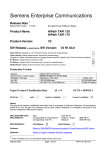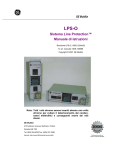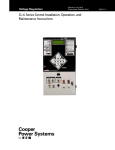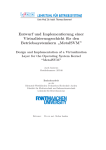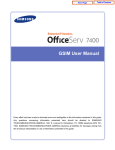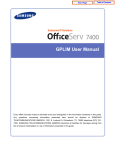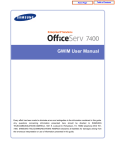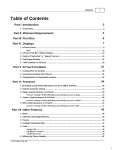Download User Manual - TriVium Systems, Inc
Transcript
Home Page
Table of Contents
User Manual
July 2004
Every effort has been made to eliminate errors and ambiguities in the information contained in this
guide. Any questions concerning information presented here should be directed to SAMSUNG
TELECOMMUNICATIONS AMERICA, 1301 E. Lookout Dr. Richardson, TX. 75082 telephone (972)
761-7300. SAMSUNG TELECOMMUNICATIONS AMERICA disclaims all liabilities for damages
arising from the erroneous interpretation or use of information presented in this guide.
Home Page
Table of Contents
Samsung Telecommunications
Publication Information
SAMSUNG TELECOMMUNICATIONS AMERICA reserves the right without prior notice to revise
information in this publication for any reason.
SAMSUNG TELECOMMUNICATIONS AMERICA also reserves the right without prior notice to
make changes in design or components of equipment as engineering and manufacturing may
warrant.
Copyright 2004
Samsung Telecommunications America
All rights reserved. No part of this manual may be reproduced in any form or by any means—
graphic, electronic or mechanical, including recording, taping, photocopying or information retrieval
systems—without express written permission of the publisher of this material.
PRINTED IN USA
07/04
Home Page
Table of Contents
Table of Contents
Purpose ....................................................................................................................... 1
Document Content and Organization........................................................................... 1
Conventions................................................................................................................. 2
Console Screen Output ............................................................................................... 3
References .................................................................................................................. 3
CHAPTER 1 ........................................................................................................................ 4
1
2
Introduction to OpenTSP ........................................................................................... 4
OpenTSP Features.................................................................................................... 5
CHAPTER 2 ........................................................................................................................ 6
OpenTSP Driver Installation..................................................................................................... 6
1
Installation Environment and Conditions.................................................................... 7
1.1
Installation Environment .................................................................................. 7
2
3
4
1.2
Installation Conditions ..................................................................................... 8
1.3
Checking the Telephony Service....................................................................13
OpenTSP Driver Installation Procedure....................................................................16
Checking Installation Data ........................................................................................22
3.1 Checking the OpenTSP Driver Files ...............................................................22
3.2 Checking the OpenTSP Driver Registration ....................................................23
3.3 Changing the OpenTSP Driver Environment Settings.....................................24
Removing the OpenTSP Driver ................................................................................27
CHAPTER 3 ......................................................................................................................30
OpenTSP Window Description ...............................................................................................30
1
OpenTSP Config Tool ...............................................................................................31
2
Scavenger Tool.........................................................................................................32
3
TAPI Sampler ...........................................................................................................33
CHAPTER 4 ......................................................................................................................35
OpenTSP Driver Guide ............................................................................................................35
1
Environment Setup Procedure..................................................................................36
1.1 Setup through the Phone and Modem Options (Advanced tab) ......................36
2
3
1.2 Setup through OpenTSP Config Tool..............................................................39
Call Processing ........................................................................................................40
2.1 Call Processing of the Phone Dialer Program .................................................40
2.2 Call Processing of the TAPI Sampler ..............................................................44
Checking Call Processing Messages through the Message Viewer Tool ..................47
Home Page
Table of Contents
CHAPTER 5 ...................................................................................................................... 49
TAPI Functions........................................................................................................................ 49
1
Relationship Between the TAPI and TSPI................................................................ 49
2
List of the TAPI Functions........................................................................................ 51
3
Feature List of the Expansion Functions in the OpenTSP Driver ............................. 54
3.1
Station Lock .................................................................................................. 55
3.2
3.3
3.4
3.5
3.6
Vacant Station Message ............................................................................... 56
Follow Me...................................................................................................... 57
Make New Trunk Call .................................................................................... 58
Page.............................................................................................................. 59
System Hold Retrieval................................................................................... 60
3.7
3.8
3.9
3.10
Clear Message Waiting ................................................................................. 61
Clear Call Back ............................................................................................. 62
OHVA............................................................................................................ 63
Silent Monitoring ........................................................................................... 64
3.11 Mute On/Off .................................................................................................. 65
3.12 Line Reset ..................................................................................................... 66
CHAPTER 6 ...................................................................................................................... 68
Call Processing Flow.............................................................................................................. 68
1
2
Life Cycle of the TAPI .............................................................................................. 68
Call Processing Events for the OpenTSP Driver...................................................... 70
2.1 Major Events ................................................................................................. 70
2.2 Flow Chart of Call Status............................................................................... 71
2.3 Flow Chart of the Status of Calls in Progress ................................................ 72
2.4
2.5
2.6
Details of Calls .............................................................................................. 73
Holding Calls in Progress .............................................................................. 74
Procedure for Consult Transfer ..................................................................... 76
ABBREVIATION ............................................................................................................... 79
Home Page
Table of Contents
Purpose
The OpenTSP User Manual provides a brief description of the Samsung OfficeServ
OpenTSP, the installation procedure, and the procedure on using the functions of the
OpenTSP, for engineers who develop the TAPI service and telephony application
programs.
Document Content and Organization
This manual includes six chapters and the ‘Acronyms’. The chapters are summarized
as follows:
CHAPTER 1. Introduction
This chapter provides an overview description of the Microsoft TAPI system used on
the OfficeServ telephone systems, a list of standard supported functions, and a list of
Samsung Specific functions used only on the Samsung TSP driver.
CHAPTER 2. OpenTSP Driver Installation
This chapter describes items that must be checked before installing the OpenTSP
driver and the procedure for installing the OpenTSP driver.
CHAPTER 3. OpenTSP Window Description
This chapter provides descriptions of the screens, toolbars, and buttons of the various
tools created during the installing the OpenTSP driver.
CHAPTER 4. OpenTSP Driver Guide
This chapter provides the procedure on dialing, receiving, and disconnecting calls
through the OpenTSP driver.
CHAPTER 5. TAPI Functions
This chapter describes the TAPI functions and expansion functions supported by the
OpenTSP driver.
1
Home Page
Table of Contents
CHAPTER 6. Call Processing Flow
This chapter describes the life cycle of the TAPI, various call processing events of the
OpenTSP driver, and the call processing procedure.
ABBREVIATION
The frequently used abbreviations and acronyms and their meanings in this guide are
all collected and explained.
Conventions
The following special paragraphs are used in this document to point out information
that must be read. This information may be set-off from the surrounding text, but is
always preceded by a bold title in capital letters.
WARNING
Indicates a potentially hazardous situation which if not avoided, could result in death
or serious injury.
CAUTION
Indicates a potentially hazardous situation which if not avoided, may result in minor or
moderate injury. It may also be used to alert against unsafe practices.
CHECKPOINT
Provides the operator with checkpoints for stable system operation.
NOTE
Indicates additional information as a reference.
OPERATION PROCEDURES
Indicates the operation procedures that should be executed in order.
2
Home Page
Table of Contents
Console Screen Output
The lined box with ‘Courier New’ font will be used to distinguish between
the main content and console output screen text.
‘Bold Courier New’ font will indicate the value entered by the operator on
the console screen
References
OfficeServ Operator Manual
The OfficeServ Operator Manual describes the main features, installation procedure,
service settings, and user guide of the OfficeServ Operator, an application program
for telephony communication.
OfficeServ Call Manual
The OfficeServ Call Manual describes the main features, installation procedure,
service settings, and user guide of the OfficeServ Call, an application program for
telephony communication.
3
Home Page
Table of Contents
CHAPTER 1
1
Introduction to OpenTSP
The OpenTSP Telephony Service Provider Driver 3.x (referred to as ‘OpenTSP’
hereinafter) interfaces with the Samsung OfficeServ telephone system through the
TCP/IP system, based on the Microsoft TAPI 2.x/TAPI 3.x, specifications and
enables call control and call processing of the Telephony Application Programming
Interface(TAPI) service through the TSPI.
The OpenTSP driver is installed on a PC using the Windows O/S.
The Microsoft TAPI consists of the three modules shown below:
Window based PC
Telephony
Application
TAPI
TAPI
Service
TSPI
Telephony
Service
Provider
Phone System
(PBX, Key Telephone
System etc.)
TAPI Configuration Diagram
4
Home Page
Table of Contents
Modules in Figure 1.1 are described below:
Telephony Application
Supplied by the application vendor, the Telephony Application provides features such
as call processing to the users through TAPI, an API provided by the Microsoft TAPI
Service.
Telephony applications include the ‘dialer’ program, embedded in the Windows OS,
and Outlook, the Contact Manager program of Microsoft.
TAPI Service
As a basic module of the Microsoft Windows OS, the TAPI Service uses the
Telephony Service Provider installed on a PC upon the request of the application
program.
Telephony Service Provider (TSP)
Provided by the switch vendor, the TSP is a service provider that communicates with
the Microsoft TAPI. The TSP is executed when the application program requests the
TAPI feature.
2
OpenTSP Features
The Samsung OpenTSP driver is a Microsoft Windows compatible TSP, the
Telephony Application program connects to the TAPI Service through a Computer
telephony interface to use the features of the Samsung key telephone system.
The OpenTSP referrers to the appropriate Microsoft TAPI specifications, and
supports the features introduced in Section‘5.2. (TAPI Functions) of this manual.’
The following system specific features that are supplied only by the OpenTSP driver
are described in detail in ‘Section 5.3. OpenTSP Driver Extended Function Feature
List’.
Station Lock
Vacant Station Message
Follow me
Make new trunk call
Page
System hold retrieval
Clear Message Waiting
Clear Call back
OHVA
Silent Monitoring
Mute on/off
Line Reset Function
5
Home Page
Table of Contents
CHAPTER 2
OpenTSP Driver Installation
This chapter describes the environment and procedure required for the installation of
the OpenTSP driver. For proper installation and operation of the OpenTSP driver, the
installation environment and conditions should be checked before installation.
Refer to the table below, in which the installation procedure is summarized, when
installing the OpenTSP driver.
Table 2.1 OpenTSP Driver Installation Procedure
Step
Procedure
Description
1
Installation Environment and
Check the following environment and condition before
Conditions
installing the OpenTSP driver.
- Check the H/W and S/W environments.
- Check for the OpenTSP driver licence key.
- Check if the OfficeServ Link program has been installed.
- Previous versions of Samsung TAPI drivers should not be
on the system.
2
OpenTSP Driver Installation
Install the OpenTSP driver according to the installation
Procedure
procedure.
Read the Cautions and Notes carefully to prevent error
during installation.
3
Installation Data Verification
After installing the OpenTSP driver, check if the installation is
successful by verifying the driver file and the registration
status.
6
Home Page
Table of Contents
1
Installation Environment and Conditions
The OpenTSP driver may be installed and executed for call processing on various
versions of Microsoft Windows. This section describes the environment and
conditions that are required for proper installation of the OpenTSP driver.
1.1
Installation Environment
Check the installation environment below before installing the OpenTSP driver.
Table 2.2 OpenTSP Driver Installation Environment
Type
Hardware
Category
Compatible Switch
Requirement
iDCS 100 Version 1.34 or higher
iDCS 500 Version 1.35 or higher
iDCS 500 R2 Version 2.13 or higher
Switch Interface
The OpenTSP may only use the switch service through a
separate S/W called OfficeServ Link.
Network Interface
A network card supporting TCP/IP protocol should be installed
on the PC.
Software
TAPI version
TAPI 2.x or higher
Operating system
Windows 2000 Professional / Server
Windows XP Professional
7
Home Page
Table of Contents
1.2
Installation Conditions
Check the items below before installing the OpenTSP driver on the system.
Valid Licence
The licence key is required for installing and using the OpenTSP driver.
Refer to your Samsung Dealer for details of how to obtain a licence.
OfficeServ Link Program
The OfficeServ Link program must be installed to use the CTI features of the
Samsung telephone system. All CTI application programs are connected to the switch
through the OfficeServ Link program.
OfficeServ Link Program
The OfficeServ Link program is software that enables multiple CTI application
programs to connect to the switch, and controls the message flow between the
application programs and the switch. Refer to the OfficeServ Link Manual for details
such as installation and operation of the OfficeServ Link program.
Samsung TSP Driver
Delete previous versions of the Samsung TSP driver, if any, before installing the new
driver.
Previous versions of the Samsung TSP driver may be installed in the following cases
If the Samsung TAPI 2.x was installed on a PC using the Windows NT or 2000
Server OS
If the computer where the Samsung TAPI 2.x driver was installed is set as the
Telephony Client
If iDCS Call Version 5.1 or lower is installed
8
Home Page
Table of Contents
The procedure for checking the information on the TSP driver installed on the
computer is as follows:
1) Select ‘Start Settings Control Panel’ on the computer.
Figure 2.1 Starting the Control Panel
2) Double click ‘Phone and Modem Options’ from the ‘Control Panel’ shown below:
Figure 2.2 Selecting Phone and Modem Options
9
Home Page
Table of Contents
3) Select [Edit (E)] from the ‘Phone and Modem Options’ window.
Figure 2.3 Phone and Modem Options Window
10
Home Page
Table of Contents
4) Enter the fields of the ‘Edit Location’ Window by referring to the figure below
and click the [OK] button.
Figure 2.4 Edit Location Window
Select ‘Country/Region’ and enter your area code. Do not enter ‘0’ of the area code.
For example, if the area code is 031, enter ‘31’.
The ‘Dialing Rules’ option is used for making external calls through TAPI.. Enter the
number to be used for making external calls. In Australia the number assigned for
outside calls is usually ‘0’.
Dialing Rules
Since phones in offices usually connect to the trunk line through a private switch,
consult the telephony manager of your company for information on the number
assigned for outside calls.
11
Home Page
Table of Contents
5) Select the ‘Advanced’ tab from the ‘Phone and Modem Options’ screen to
display the list of drivers (telephony service providers) installed on the system.
Figure 2.5 Advanced Tab of Phone and Modem Options
The TAPI compatible driver can be installed separately on each computer, and a
newly added TAPI driver is displayed on the ‘Advanced’ tab of the ‘Phone and
Modem Options’.
The TAPI driver is registered as ‘Samsung SCTSP32 TAPI2.x Compatible Telephony
Service Provider’ or ‘Samsung DCSTSP Telephony Service Provider’.
12
Home Page
Table of Contents
1.3
Checking the Telephony Service
The procedure for checking if the Telephony service is normally operating is as
follows:
1) Select ‘Start Settings Control Panel’ from the computer.
Figure 2.6 Executing the Control Panel
2) Double click the ‘Administrative Tools’ from the control panel below.
Figure 2.7 Selecting Administrative Tools
13
Home Page
Table of Contents
3) Select ‘Service’ from the ‘Administrative Tools’ window.
Figure 2.8 Selecting Service
4) Check the ‘Telephony’ service (TAPI service) status from the ‘Service’ window
below. If the ‘Telephony’ service is displayed as ‘started’, as shown below, the
TAPI service is operating.
Figure 2.9 Service Window
Terminating/Restarting the Telephony Service
Users can terminate or restart the telephony service, if necessary, through the above
window.
14
Home Page
Table of Contents
5) The telephony service of the Windows OS is related to the following services.
Thus, the services below should be checked for normal operation.
Remote Access Auto Connection Manager
Remote Access Connection Manager
These two Services should be set to Disable or Manual (and stopped) for normal
operation.
Figure 2.10 Telephony Service
Cases where the OpenTSP Driver is not Properly Loaded or Unloaded
If the two services above are operated ‘Manually’ the two services will act as a single
module of the telephony service. If the two services were abnormally set during the
system setup procedure, the two services and the telephony service may not operate
normally and the OpenTSP driver may not be loaded or unloaded properly, disabling
the use of related application programs. To avoid such incidents, it is recommended to
set the start type as ‘Disabled’ to disable unnecessary services. If the two services are
marked as ‘Started’ and the OpenTSP does not operate properly, change the ‘start
type’ to ‘Disabled’ and reboot the system.
15
Home Page
Table of Contents
2
OpenTSP Driver Installation Procedure
The procedure for installing the OpenTSP driver is as follows:
1) Double click the OpenTSP installation file (Setup.exe) on the CD-ROM.
2) Click the [Next>] button on the screen below.
Figure 2.11 Installation Window
3) Read the Licence Agreement below and select [Yes] to approve. Select [No] to
abort the installation program.
Figure 2.12 Licence Agreement
16
Home Page
Table of Contents
4) The ‘Choose Destination Location’ window appears as shown below. Click the
[Next>] button to use the default path (C:\Program Files\Samsung Telephony
Service Provider) or click the [Browse] button to change the installation folder.
Figure 2.13 Selecting Installation Folder
OpenTSP Driver Installation Folder
The OpenTSP installation program installs two types of programs on the user’s
computer.
The SCTSP32.TSP file (basic Telephony Service Provider file) is copied to the
C:\WINNT\system32 folder and is registered to TAPI.
Utility programs required for installing and operating the OpenTSP driver are copied
to the C:\Program Files\Samsung Telephony Service Provider folder.
Thus, the folder selected during the installation procedure above (C:\Program
Files\Samsung Telephony Service Provider) is the location to where the utility
programs are copied.
17
Home Page
Table of Contents
5) Select ‘Typical’ from the ‘Setup Type’ window below and click the [Next>] button.
Figure 2.14 Selecting Installation Type
6) The ‘Select Program Folder’ window below appears. Click the [Next>] button to
use the default name (Samsung Telephony Service Provider). Enter a new name
into the field to change the folder name.
Figure 2.15 Selecting Installation Folder
18
Home Page
Table of Contents
7) Enter the entry items of the ‘Phone and Modem Options’ window below.
Figure 2.16 Phone and Modem Options
‘Dialing Rules’ Setup
Refer to the steps from 1) to 4) of the ‘Samsung TAPI Driver’‘ in ‘1.2 Installation
Conditions’ for setting the ‘Dialing Rules’.
19
Home Page
Table of Contents
8) Enter the items of the ‘Communication Parameters’ window below and click the
[OK] button.
Figure 2.17 Communication Parameters
Trace Type
The Trace Type setup affects the performance of the OpenTSP driver and should be
set to ‘None’ under normal circumstances. Change the setting to ‘Level 1’ or ‘Level 2’
only when instructed by a trained support engineer.
If the OpenTSP is installed when OfficeServ Link is not operating
Though the OpenTSP driver can be installed while the OfficeServ Link is not
operating, the CTI application program automatically attempts connection to the
corresponding port after the installation. Thus, the ‘Communication Parameter’ should
be set to enable connection to the OfficeServ link before starting the CTI application
program.
20
Home Page
Table of Contents
9) Upon successful installation of the OpenTSP driver, the ‘OpenTSP Setup
Complete’ window appears. Click the [Finish] button.
Figure 2.18 Installation Complete
21
Home Page
Table of Contents
3
Checking Installation Data
3.1
Checking the OpenTSP Driver Files
During the installation of the OpenTSP driver, the OpenTSP driver and utilities
should have been copied to the folders below:
Location of the OpenTSP driver file
The OpenTSP driver is copied to different folders depending on the OS.
Windows NT/Windows 2000 : Winnt\System32\sctsp32.tsp
Windows XP : Windows\system32\sctsp32.tsp
Windows 98/Me : windows\system\sctsp32.tsp
Location of the OpenTSP driver utility files
The OpenTSP utility files should have been copied to the folder below if the default
location in ‘Figure 2.15 Selecting Installation Folder’ was not changed.
Program Files\Samsung Electronics\Samsung Telephony Service Provider
Utilities for OpenTSP driver
The utilities required for installing/operating the OpenTSP driver are as follows:
Scavenger.exe : Program for removing Mismatch Call Handle
TAPISampler.exe : Test program for simple dialing/receiving/disconnecting calls
and for tracking call status/data
OpenTSP Config Tool : Communication environment setup program for
OpenTSP driver
22
Home Page
Table of Contents
As shown below, the utility programs are located at ‘Start Programs OfficeServ
OpenTSP Driver’ for convenient use.
Figure 2.19 OpenTSP Utility Program
3.2
Checking the OpenTSP Driver Registration
The registration of the OpenTSP driver file, which is registered as the TAPI driver of
the Microsoft Windows OS, can be verified as follows. :
Check for the ‘Samsung SCTSP32 TAPI2.x Compatible Telephony Service Provider’
on the ‘Advanced’ tab of the ‘Start Control Panel Phone and Modem Options’.
Figure 2.20 Advanced Tab of Phone and Modem Options
23
Home Page
Table of Contents
3.3
Changing the OpenTSP Driver Environment Settings
The user may change the environment settings of the OpenTSP driver. The driver
environment can be changed either through the ‘Phone and Modem Options’ screen
or through the OpenTSP Config Tool program.
Changing from the ‘Phone and Modem Options’ screen
1) Click the [Configure] button from the ‘Start Control Panel Phone and
Modem Options Advanced’ screen.
Figure 2.21 Selecting Configure
24
Home Page
Table of Contents
2) On the OpenTSP environment configuration screen below, change the settings
and click the [OK] button.
Figure 2.22 Communication Parameters
3) The message below appears to confirm the changes.
Figure 2.23 Confirming Changes in Environment Settings
4) The OpenTSP driver must be restarted to apply the changes. Thus, close all CTI
application programs and restart the OpenTSP driver.
25
Home Page
Table of Contents
Using the OpenTSP Config Tool program
The OpenTSP Config Tool program, which allows the user to change the
configuration of the OpenTSP driver, is installed in the OpenTSP driver installation
folder. Through this program, users can easily check and change the settings.
The procedure for changing the OpenTSP driver environment through the OpenTSP
Config Tool program is as follows:
1) Execute the ‘OpenTSP Config Tool’ under the ‘Start Programs OfficeServ
OpenTSP Driver’. The screen below is displayed.
Figure 2.24 Closing TAPI Compatible Program
2) The message above informs the user that all TAPI compatible programs need to
be closed before changing the environment settings. Close all TAPI compatible
programs that are currently operating and click the [OK] button.
3) Enter the fields in the window shown below and click the [OK] button.
Figure 2.25 OpenTSP ConfigTool
OpenTSP Configuration Tool
Refer to item 9) of the ‘2 OpenTSP Driver Installation Procedure’ for detailed
descriptions of each field.
26
Home Page
Table of Contents
4
Removing the OpenTSP Driver
Remove the OpenTSP driver installed on the system when the driver is no longer
needed or when removing a previous version to install a new version of the driver.
Closing all TAPI compatible programs
All TAPI compatible application programs that are currently running must be closed
before removing the OpenTSP driver. If the OpenTSP driver is being operated by a
TAPI compatible application program, error may occur during the uninstallation
process.
The procedure for removing the OpenTSP driver is as follows:
1) Select ‘Start Settings Control Panel Add/Delete Program’ to display the
screen below. Then, select the ‘Samsung Telephony Service Provider’ and click
the [Change/Remove] button.
Figure 2.26 Add/Delete Program
27
Home Page
Table of Contents
2) Among the radio buttons, select the ‘Remove’ item and click the [Next>] button.
Figure 2.27 Delete Window
3) Click [OK] on the below message window confirming the removal of the
OpenTSP driver files.
Figure 2.28 Confirm Deletion
4) The window below appears to confirm the deletion of the C:\WINNT\System32
\SCT32.TSP file. Click the [Retry] button to delete this file.
Figure 2.29 Confirm File Deletion
28
Home Page
Table of Contents
5) Files related to the OpenTSP driver are removed from the system. Click the
[Finish] button on the screen below.
Figure 2.30 Deletion Complete
29
Home Page
Table of Contents
CHAPTER 3
OpenTSP Window Description
This chapter provides description on the screens, toolbars, and buttons of the various
tools offered by the OpenTSP.
Tools provided by the OpenTSP are displayed as five submenus under the ‘Programs
OfficeServ OpenTSP Driver’.
Figure 3.1 OpenTSP Submenu
Tools provided by the OpenTSP are as follows:
OpenTSP Config Tool
Scavenger Tool
TAPI Sampler
30
Home Page
Table of Contents
1
OpenTSP Config Tool
The OpenTSP Config Tool allows the user to set the network information, Trace Type,
and the Licence Key of the OfficeServ Link, to which the TSP connects.
Figure 3.2 OpenTSP Config Tool Screen
Server IP Address: Enter the IP address of the computer where the OfficeServ
Link is installed. The OfficeServ Link program may or may not be installed and
operated on the same computer where the OpenTSP driver is installed.
Server Port No: This is the number of the port where the OfficeServ Link
program is waiting for connection. The default number is 6000. This port
number should be set as the same port number set at the OfficeServ Link
program.
Trace Type: The OpenTSP driver displays its operation data through the Tool
(DBGView.exe). Set the details of the operation data to be displayed.
− None : No display(default)
− Level 1: Displays only basic information.
− Level 2: Displays detail information.
31
Home Page
Table of Contents
2
Scavenger Tool
The Scavenger Tool allows the user to initialize the TSP driver without restarting the
driver during operation.
This can be used to remove the call details from one or more devices if required.
This tool should be used with care and only under instruction from a trained engineer.
Figure 3.10 Scavenger Tool
Item
Setup
Description
Displays the Scavenger option setup screen.
On the option setup screen, select the phone line from which the Call details
should be removed and specify the operation time.
Close
Sends the Scavenger Tool to the system tray.
Exit
Closes the Scavenger Tool.
32
Home Page
Table of Contents
3
TAPI Sampler
The TAPI Sampler is a utility program that dials, receives, or disconnects calls
through the OpenTSP driver or displays various TAPI events received by the
application programs through the TAPI service.
Start the TAPI Sampler while the OfficeServ Link program is normally operating to
display the screen below.
Call Status
Window
Message Status
Window
Figure 3.15 TAPI Sampler Screen
As shown above, the TAPI Sampler is simply configured.
My Extension: Select the number of the device to be used by the TAPI Sampler.
Destination: Enter the destination number for an intercom/external call.
Call Status Window: Displays the progress of call origination/termination.
Detail Message Information Window: Displays detail information on messages
the TAPI Sampler received through the TAPI service.
33
Home Page
Table of Contents
Call Status Window
Parameters of the Call Status Window are as follows:
Parameter
Description
Time
Time when the event occurred.
CallHandle
Call Handle. Displayed in 4 byte hexadecimal.
CallState
Displays the call status as Idle, Connected, Busy, etc
CallStatDetail
Displays additional information, if any, on the call status.
ConnectedID
Displays the phone number of the other party.
Message Status Window
Parameters of the Message Status Window are as follows:
Parameter
Description
Time
Time when the event was received.
Event
Displays details on the received event.
34
Home Page
Table of Contents
CHAPTER 4
OpenTSP Driver Guide
This chapter describes the procedures for dialing, receiving, and disconnecting calls
using the OpenTSP driver after successfully installing the driver on the PC.
The tools or programs used for procedures from setting the environment to
processing calls are as follows.
Step
1) Environment Setup
Item
Used Tool(Program)
Set IP address and port
Phone and Modem Options (Advanced tab),
OpenTSP Config Tool
Set Trace type
Phone and Modem Options (Advanced tab),
OpenTSP Config Tool
Set Dialing Rules
Edit location of Phone and Modem Options
(Refer to ‘1.3 Checking Telephony Service’
in Chapter 2.)
2) Call Processing
Dialing, receiving, or
3) Checking Call
OpenTSP driver
disconnecting calls
Processing Messages
Programs Accessories Communication
Dial, TAPI Sampler
Programs Accessories Communication
operation status
Dial, Message viewer, TAPI32 Browser
Execute OpenTSP TAPI
TAPI32 Browser
call function
Receive call processing
Message viewer
result log
TAPI Compatible Application Program
TAPI Compatible Application Programs can be used when the OfficeServ Link
program is connected through the OpenTSP driver and is operating normally.
35
Home Page
Table of Contents
1
Environment Setup Procedure
There are two ways to set the environment for setting the IP address and port, for
selecting the trace type, and for entering the licence key.
Phone and Modem Options(Advanced tab)
OpenTSP Config Tool
1.1
Setup through the Phone and Modem Options (Advanced tab)
Procedure for setting the environment through the Phone and Modem Options
(Advanced tab) of the OS is as follows:
1) Select ‘Start Settings Control Panel’ on the computer.
Figure 4.1 Starting Control Panel
2) Select the ‘Phone and Modem Options from the ‘Control Panel’ shown below.
Figure 4.2 Selecting Phone and Modem Options
36
Home Page
Table of Contents
3) Click the [Edit (E)] button on the ‘Phone and Modem Options’ window.
Figure 4.3 Phone and Modem Options Window
5) Select the ‘Advanced’ tab on the ‘Phone and Modem Options’ window.
Figure 4.4 Advanced Tab of Phone and Modem Options Window
37
Home Page
Table of Contents
6) Select the ‘Samsung OfficeServ OpenTSP Driver for Keyphone Series’ and click
the [Configure(C)] button.
Figure 4.5 Selecting Configure Button of Advanced Tab
7) Enter the fields of the ‘Communication Parameters’ window and click the [OK]
button.
Figure 4.6 Communication Parameters Window
Server IP Address: IP address of the PC where the OfficeServ Link is installed.
Server Port No: Use the default number, 6000. (This port number should be set
as the same port number set at the OfficeServ Link program.)
Trace Type: Select ‘Level 1’ or ‘Level 2’ to display call processing messages or
select ‘None’ not to display messages.
38
Home Page
Table of Contents
1.2
Setup through OpenTSP Config Tool
Procedure for setting the OpenTSP driver environment through the OpenTSP Config
Tool is as follows:
1) Execute the ‘OpenTSP Config Tool’ under the ‘Start Programs OfficeServ
OpenTSP Driver’. The screen below is displayed.
Figure 4.7 Closing TAPI Compatible Program
2) The message above informs the user that all TAPI compatible programs need to
be closed before changing the environment settings. Close all TAPI compatible
programs that are currently operating and click the [OK] button.
3) Enter the fields in the window shown below and click the [OK] button.
Figure 4.8 OpenTSP Config Tool
39
Home Page
Table of Contents
2
Call Processing
2.1
Call Processing of the Phone Dialer Program
A dialing program is installed as standard in all versions of Windows.
Dialing Procedure
Procedure for dialing through the ‘Phone Dialer’ is as follows:
1) Connect the Samsung Key telephone system and the OfficeServ Link program
through the CTI link.
2) Execute the ‘Phone Dialer’ program of the PC by clicking [Start Programs
Accessories Communication Phone Dialer]. The ‘Phone Dialer’ screen
shown below appears.
Figure 4.9 Phone Dialer Screen
3) Select [Edit Option] and display the screen below.
Figure 4.10 Option Screen
40
Home Page
Table of Contents
Default line for dialing: Select ‘Telephone’ since the OpenTSP driver is used for
line telephones.
− Telephone (O): Selects the communication line for line telephones.
− Internet (N): Selects the communication line for Internet lines.
Used lines: Applies according to the default line used for dialing.
− Phone (P): Sets telephone lines. This number should be identical to the
actual extension number of the Samsung switch.
− Internet Communication(I) :
− Internet Conference(F) :
4) The settings of the ‘Line’ tab are displayed below. The ‘DCS Line 2001’ in the
‘Phone’ field represents that the extension number is 2001. The OpenTSP driver
displays the device list of the Samsung key telephone system as ‘DCS Line
XXXX (extension number)’.
Figure 4.11 Line Tab of Option Screen
41
Home Page
Table of Contents
5) Select the ‘Audio/Video (A)’ tab and check if the ‘Line’ item of the ‘Dialing
Device’ is set to Telephone, and click the [OK] button.
Figure 4.12 Audio/Video Tab of Option Screen
6) From the ‘Phone Dialer’ screen below, click ‘Phone Dial’.
Figure 4.13 Selecting Dial from Phone Dialer Screen
7) From the ‘Dial’ screen below, check if the ‘Dialing Pattern’ is set to Phone(P)
and enter ‘2002’ into the entry field. Then, Click the Connect(C) button.
Figure 4.14 Dialing from the Dial Screen
42
Home Page
Table of Contents
8) The screen below appears and shows that extension 2001 is dialing extension
2002.
Figure 4.15 Dialing Display Screen
9) The screen below appears upon successful connection. Select Disconnect (D) to
terminate the connection after completing the call.
Figure 4.16 Disconnecting the Call
Checking the OpenTSP driver operation
If the OpenTSP driver is successfully connected to the TAPI service through the dialing
program, the messages exchanged can be viewed through the Message Viewer.
43
Home Page
Table of Contents
2.2
Call Processing of the TAPI Sampler
Users can dial, receive, or disconnect calls through the TAPI Sampler. The OfficeServ
Link program should be normally running to ‘Dial’ using the TAPI program.
Dialing Calls
Procedure for dialing calls using the TAPI Sampler is as follows:
1) Click [Start Programs OfficeServ OpenTSP Driver TAPI Sampler Tool] as
shown below.
Figure 4.17 Executing the TAPI Sampler Tool
2) Select your extension number from the ‘My Extension’ field on the screen below
and click the ‘Open’ button.
Figure 4.18 Selecting Extension Number
44
Home Page
Table of Contents
3) Enter the destination number in the ‘Destination’ field and click the ‘Dial’ button.
Setting different numbers for the ‘My Extension’ and ‘Destination’ fields will
enable receiving calls through TAPI Sampler.
Figure 4.19 Selecting Destination Number
4) Information on the TAPI messages, sent to the TAPI Sampler by the TAPI
service, are displayed ‘Message Status Window’.
Figure 4.20 TAPI Message Display Screen
45
Home Page
Table of Contents
Receiving Calls
Calls may also be received through the TAPI Sampler program.
A call is being sent from extension 2002 to extension 2001 in the figure below.
The Call Status Window displays information on the call, such as time of event, call
status, and destination number, and the Message Status Window displays detail
information on the TAPI messages sent to the TAPI Sampler by the TAPI service.
If a call arrives, right click the information of the call on the Call Status Window to
display the Context Menu as shown below. Select [Answer] to answer the call.
Figure 4.21 Context Menu Display Screen
The Context Menu is described as follows:
CallInfo: Displays Detail information on the call on the Message Status Window.
This feature displays the result of the TAPI function, lineGetCallInfo().
Answer: Answers the call.
Drop: Disconnects the connected call.
Deallocate: Clears all displayed call information regardless of the phone status.
This feature initializes the line device managed by the OpenTSP driver and
deletes all call data on the corresponding line. (Irrespective to the actual status of
the device) This feature can be used to manually remove any inconsistencies
between the status of the actual phone and the reported status in TAPI..
46
Home Page
Table of Contents
3
Checking Call Processing Messages through the
Message Viewer Tool
The Message Viewer Tool is used for verifying the messages processed during the
operation of the OpenTSP driver.
Downloading the DBGView.exe file
As the execution file of the Message Viewer Tool, the DBGView.exe is used along
with the OpenTSP driver. Made by Sysinternal, this program is used for logging
debug messages within the Windows OS. Download and update your DBGView.exe
file from http://www.sysintenal.com.
1) Click [Start Programs OfficeServ OpenTSP Driver TAPI Sampler Tool] as
shown below:
Figure 4.22 Executing the TAPI Sampler Tool
2) The Message Viewer Tool (= DBGView.exe) screen below appears and displays
the messages exchanged during the operation of the OpenTSP driver.
Figure 4.23 DBGView.exe Screen
47
Home Page
Table of Contents
Setting the message display level
Messages on the operation status of the OpenTSP driver are displayed on the
Message viewer only when the Trace Type, the OpenTSP driver’s environment setup
item, is set to ‘Level 1’ or ‘Level 2’, and are not displayed when the Trace Type is set
to ‘None’.
Verifying the operation of the OpenTSP driver
Through the Message Viewer, users can view detail messages related to the
operation of the OpenTSP driver and can also save the displayed messages as files if
necessary.
48
Home Page
Table of Contents
CHAPTER 5
TAPI Functions
This chapter describes the features of the standard TAPI functions and Samsung
Specific functions that the OpenTSP driver supports.
1
Relationship Between the TAPI and TSPI
When the TAPI-compatible application requests a TAPI function, the Telephony
Service Provider provides the TSPI functions related to the TAPI function. That is,
the TAPI-compatible application receives the TAPI service offered by the key
telephone system through the Telephony Service Provider.
The procedure for exchanging messages between the TAPI and TSPI is shown in the
figure below:
PC
Key Telephone System
TAPI-Compatible
Application
Operating System
CTI Service
Telephony Service
Provider
Figure 5.1 Flow of Messages Between the TAPI and TSPI
Each step shown in Figure 5.1 is described below:
The TAPI-compatible application calls a TSPI function to the TAPI service of
the key telephone system in order to process calls.
The TAPI-compatible application calls a TSPI function to the Telephony Service
Provider.
The Telephony Service Provider forwards the event requested by the TAPIcompatible application to the TAPI service of the key telephone system.
The TAPI service of the key telephone system processes the event and notifies
the Telephony Service Provider of the results.
The Telephony Service Provider forwards the results received from the CTI
service of the key telephone system to the TAPI-compatible application.
49
Home Page
Table of Contents
Example of Internal Calling Using the Phone Dialer
Figure 5.2 shows the procedures for using the phone dialer offered by the PC to make
a call from Extension 2001 to Extension 2002:
PC
Ext. 2001
Ext.
Phone Dialer
TAPI Service
OpenTSP Driver
Key Telephone System
OfficeServ Link
CTI Service
Figure 5.2 Example of Internal Calling in the Phone Dialer
The commands and events to be sent or received during internal calling are processed
as described below:
lineMakeCall : The Phone Dialer uses the lineMakeCall TAPI function to press
Extension 2002 for making a call.
TSPI_lineMakeCall : The TAPI service calls the TSPI_lineMakeCall function to
the OpenTSP driver after being asked to process the TAPI function.
The OpenTSP driver creates the command that can be processed by the key
telephone system and forwards it to the OfficeServ Link program in order to
perform the functions requested by the TAPI service.
The OfficeServ Link forwards the command received from each OpenTSP
driver to the key telephone system of Samsung.
The key telephone system interprets the forwarded command to make a call
from Extension 2001 to Extension 2002.
The key telephone system forwards the extension processing results to the
OfficeServ Link.
The OfficeServ Link forwards the extension processing results received from the
key telephone system to the OpenTSP driver.
The OpenTSP driver converts the event for the processing results into the form
that can be processed by the TAPI service and forwards the event to the TAPI
service.
The TAPI service forwards the results for TAPI function processing to the
Phone Dialer through the TAPI service.
Once the steps above are completed, the Phone Dialer offers the call processing
results to users through an internal processing module.
50
Home Page
Table of Contents
2
List of the TAPI Functions
Restriction
The OpenTSP driver supports INTERACTIVEVOICE mode and only the Line
Device function out of the list of the TAPI functions of Microsoft.
List of the TAPI Functions
The list of the TAPI functions that the OpenTSP driver enables is shown below:
TAPI Functions of
Supported
Microsoft
or Not
Remarks
LineAddToConference
O
Consultation Call
LineAnswer
O
Off-Hook
LineBlindTransfer
O
Consultation Call+Transfer
LineClose
O
LineCompleteCall
O
Camp on+Msg Waiting+OHVA+Callback
LineCompleteTransfer
O
Transfer
LineDeallocateCall
O
Idle Call Remove
LineDevSpecific
O
Refer to 5.3 List of the OpenTSP Driver Expansion
LineDial
O
Make Call
LineDrop
O
On-Hook
LineForward
O
Set/Reset Forward/DND
LineGenerateDigits
O
Send DTMF Digits
LineGetAddressCaps
O
LineGetAddressID
O
Functions.
LineGetAddressStatus
O
LineGetCallInfo
O
LineGetCallStatus
O
LineGetDevCaps
O
LineGetDevConfig
O
LineGetID
O
LineGetLineDevStatus
O
LineHold
O
Hold
lineMakeCall
O
Make Call
lineNegotiateExtVersion
O
lineOpen
O
linePark
O
Direct Park : OK, UnDirect Park[=System Hold] : OK
linePickup
O
Direct Pickup+Group Pickup
51
Home Page
Table of Contents
TAPI Functions of Microsoft
Supported
Remarks
or Not
linePrepareAddToConference
O
Consultation Call
lineRedirect
O
Redirect
linePark
O
Direct Park : OK, UnDirect Park[=System Hold] : OK
lineRemoveFromConference
O
Consultation Call
lineSetAppSpecific
O
LineSetCallData
O
lineSetCallParams
O
lineSetMediaMode
O
lineSetStatusMessages
O
lineSetupConference
O
Consultation Call
lineSetupTransfer
O
Consultation Call
lineSwapHold
O
Consultation Call for T-Hold And Hold+Retrieve for
S-Hold
lineUnhold
O
Consultation Call for T-Hold and Retrieve for S-Hold
lineUnpark
O
System Hold Retrieval
The list above shows only the TAPI functions supported by the OpenTSP driver:
Some functions from the list of the TAPI functions might be processed by the TAPI
service itself. Also, some functions, which are used to add the Telephony Service
Provider to the system, are not included in the list. If the functions that are not
supported by the OpenTSP driver are called, an error message defined in the TAPI
will appear.
The user can find the entire list of the Microsoft TAPI functions from the Microsoft
site (http://www.msdn.microsoft.com/library/default.asp). The user can check the
format of each function, how to use the functions, or the status values returned from
the list and refer to the list to develop an application.
52
Home Page
Table of Contents
Figure 5.3 URL of the Entire List of Microsoft TAPI Functions
53
Home Page
Table of Contents
3
Feature List of the Expansion Functions in the
OpenTSP Driver
Besides the functions defined by the TAPI, the OpenTSP driver provides a variety of
expansion functions.
Call the lineDevSpecific function to use the expansion functions.
Enter the syntax below to call the lineDevSpecific function:
LONG lineDevSpecific (HLINE hLine,
LPVOID lpParams, DWORD dwSize);
DWORD
dwAddressID,
HCALL
hCall,
The features available by the lineDevSpecific function in the Samsung key telephone
system are as follows:
Station Lock
Vacant Station Message
Follow Me
Make New Trunk Call
Page
System Hold Retrieval
Clear Message Waiting
Clear Call Back
OHVA
Silent Monitoring
Mute On/Off
Line Reset
54
Home Page
Table of Contents
3.1
Station Lock
The Station Lock disables other users from using their own phones to make or answer
calls.
The available modes are as follows:
Unlock: Release lock.
Locked all: Lock call outgoing and incoming.
Enter the syntax below to call the lineDevSpecific function when the Station Lock is
used in the TAPI application:
LONG lineDevSpecific (HLINE hLine,
LPVOID lpParams, DWORD dwSize);
DWORD
dwAddressID,
Input Parameter Values
hLine : Processes the lines to be used.
dwAddressID : 0
hCall : Not used
lpParams : Enters the command strings as shown below :
Value
Byte
‘D’ ‘C’ ‘S’
3 Bytes
‘L’
1 Byte
Option :
1 Byte
0-Unlock
2-Lock All
Phone Password
Up to 4 bytes
DwSize : Buffer length(Null value included)
55
HCALL
hCall,
Home Page
Table of Contents
3.2
Vacant Station Message
The Vacant Station Message enables the phone to display a vacant message on the
LED of the caller’s extension phone when a user sets the ‘vacant message’ to the
user’s phone before he or she is away from the phone.
Number of Vacant Messages
The number of vacant messages that can be set to the system depends on the
Samsung key telephone systems.
Enter the syntax below to call the lineDevSpecific function when the Vacant Station
Message is used in the TAPI application:
LONG lineDevSpecific (HLINE hLine,
LPVOID lpParams, DWORD dwSize);
DWORD
dwAddressID,
Input Parameter Values
hLine : Processes the lines to be used.
dwAddressID : 0
hCall : Not used
lpParams : Enters the command strings as shown below :
DwSize : Buffer length(Null value included)
Value
Byte
‘D’ ‘C’ ‘S’
3 Bytes
‘V’
1 Byte
Message number(Hexa value) :
1 Byte
0-Clears a message.
1~20-Number of the messages
56
HCALL
hCall,
Home Page
Table of Contents
3.3
Follow Me
The Follow Me function enables call forwarding so that the user can answer a call
even if the user is away from the phone. This feature is the same as ‘call forwarding
unconditional.’ However, the ‘call forwarding unconditional’ is set in the user’s
phone while the Follow Me is set in another phone.
Enter the syntax below to call the lineDevSpecific function when the Follow Me is
used in the TAPI application:
LONG lineDevSpecific (HLINE hLine,
LPVOID lpParams, DWORD dwSize);
DWORD
dwAddressID,
Input Parameter Values
hLine : Processes the lines to be used.
dwAddressID : 0
hCall : Not used
lpParams : Enters the command strings as shown below :
DwSize : Buffer length(Null value included)
Value
Byte
‘D’ ‘C’ ‘S’
3 Bytes
‘F’
1 Byte
Phone number to be forwarded
Up to 4 Bytes
57
HCALL
hCall,
Home Page
Table of Contents
3.4
Make New Trunk Call
The Make New Trunk Call enables the user to make a trunk call continuously without
making the call again even after the trunk call is completed.
Enter the syntax below to call the lineDevSpecific function when the Make New
Trunk Call is used in the TAPI application:
LONG lineDevSpecific (HLINE hLine,
LPVOID lpParams, DWORD dwSize);
DWORD
dwAddressID,
Input Parameter Values
HLine : Processes the lines to be used.
dwAddressID : 0
hCall : Not used
lpParams : Enters the command strings as shown below :
DwSize : Buffer length(Null value included)
Value
Byte
‘D’ ‘C’ ‘S’
3 Bytes
‘T’
1 Byte
Digit of the dialed phone number-n
1 Byte
Digit to be dialed
n Byte(s)
58
HCALL
hCall,
Home Page
Table of Contents
3.5
Page
The Page enables the user to give a notice to people simultaneously through the
speaker installed on the key telephone (or the external speaker installed separately).
The page is categorized into internal page and external page. The internal page is
made to the key phones, which are set as the internal page zone of the current key
telephone system. The external page is made through the speakers, which are set as
the external page zone. When the external page is made, an external speaker should
be set in the <System Programming> of the Samsung key telephone system.
Enter the syntax below to call the lineDevSpecific function when the Page is used in
the TAPI application:
LONG lineDevSpecific (HLINE hLine,
LPVOID lpParams, DWORD dwSize);
DWORD
dwAddressID,
Input Parameter Values
hLine: Processes the lines to be used.
dwAddressID : 0
hCall : Not used
lpParams : Enters the command strings as shown below :
DwSize : Buffer length(Null value included)
Value
Byte
‘D’ ‘C’ ‘S’
3 Bytes
‘P’
1 Byte
Number of page
1 Byte
The page zone numbers are described below:
‘1’~‘4’ : Internal page zone
‘5’~‘8’ : External page zone
‘0’ : Entire internal page
‘9’ : Entire external page
‘*’ : Entire internal/external page
59
HCALL
hCall,
Home Page
Table of Contents
3.6
System Hold Retrieval
The System Hold Retrieval enables the user to ‘hold’ an incoming call momentarily
and answer the call from another extension.
Enter the syntax below to call the lineDevSpecific function when the System Hold
Retrieval is used in the TAPI application:
LONG lineDevSpecific (HLINE hLine,
LPVOID lpParams, DWORD dwSize);
DWORD
dwAddressID,
HCALL
Input Parameter Values
hLine : Processes the lines to be used.
dwAddressID : 0
hCall : Not used
lpParams : Enters the command strings as shown below :
DwSize : Buffer length(Null value included)
Value
Byte
‘D’ ‘C’ ‘S’
3 Bytes
‘S’
1 Byte
Number of the calls on hold
Up to 4 Bytes
60
hCall,
Home Page
Table of Contents
3.7
Clear Message Waiting
The Clear Message Waiting disables the message waiting LED to be displayed when
a message is left in the user’s phone.
Checking if a message has been left
In the Samsung key telephone system, the LED on the message button of the
connected phone turns on to notify the other party that a message has been left when
a caller leaves the message because the caller cannot speak to the other party.
Enter the syntax below to call the lineDevSpecific function when the Clear Message
Waiting is used in the TAPI application:
LONG lineDevSpecific (HLINE hLine,
LPVOID lpParams, DWORD dwSize);
DWORD
dwAddressID,
Input Parameter Values
hLine : Processes the lines to be used.
dwAddressID : 0
hCall : Not used
lpParams : Enters the command strings as shown below :
DwSize : Buffer length(Null value included)
Value
Byte
‘D’ ‘C’ ‘S’
3 Bytes
‘M’
1 Byte
Number of the devices where a message is left
Up to 4 Bytes
61
HCALL
hCall,
Home Page
Table of Contents
3.8
Clear Call Back
The Call Back enables the user to make a call reservation when the other party is on
the phone or does not answer. Then, a caller’s phone rings automatically when the
other party’s phone becomes available. The Clear Call Back disables the Call Back.
Enter the syntax below to call the lineDevSpecific function when the Call Back is
used in the TAPI application:
LONG lineDevSpecific (HLINE hLine,
LPVOID lpParams, DWORD dwSize);
DWORD
dwAddressID,
Input Parameter Values
hLine : Processes the lines to be used.
dwAddressID : 0
hCall : Not used
lpParams : Enters the command strings as shown below :
DwSize : Buffer length(Null value included)
Value
Byte
‘D’ ‘C’ ‘S’
3 Bytes
‘C’
1 Byte
Phone number to which a reservation has been made
Up to 4 Bytes
62
HCALL
hCall,
Home Page
Table of Contents
3.9
OHVA
The Off Hook Voice Announcement (OHVA) enables a caller to leave a message in
the other party’s phone when the other party is on the phone. This is useful when the
caller needs to leave a message urgently.
Enter the syntax below to call the lineDevSpecific function when the OHVA is used
in the TAPI application:
LONG lineDevSpecific(HLINE hLine,
LPVOID lpParams, DWORD dwSize);
DWORD
dwAddressID,
Input Parameter Values
hLine : Processes the lines to be used.
dwAddressID : 0
hCall : Not used
lpParams : Enters the command strings as shown below :
DwSize : Buffer length(Null value included)
Value
Byte
‘D’ ‘C’ ‘S’
3 Bytes
‘I’
1 Byte
Phone number for the OHVA
Up to 4 Bytes
63
HCALL
hCall,
Home Page
Table of Contents
3.10 Silent Monitoring
The Silent Monitoring enables a caller to speak to the extension subscriber by
interruption even while the subscriber is on the phone. In the Samsung key telephone
system, the Silent Monitoring operates in ‘Without Tone (the monitored subscriber
does not the monitoring sound).’
Enter the syntax below to call the lineDevSpecific function when the Silent
Monitoring is used in the TAPI application:
LONG lineDevSpecific(HLINE hLine,
LPVOID lpParams, DWORD dwSize);
DWORD
dwAddressID,
Input Parameter Values
hLine : Processes the lines to be used.
dwAddressID : 0
hCall : Not used
lpParams : Enters the command strings as shown below :
DwSize : Buffer length(Null value included)
Value
Byte
‘D’ ‘C’ ‘S’
3 Bytes
‘B’
1 Byte
Phone number for silent monitoring
Up to 4 Bytes
64
HCALL
hCall,
Home Page
Table of Contents
3.11 Mute On/Off
The Mute On/Off enables (Mute Off) or disables (Mute On) the other party to listen
to a caller’s voice while the caller is speaking to the other party or is on the Intrude or
Silent Monitoring. Although a caller sets the Mute On, the caller can listen to the
other party’s voice.
Enter the syntax below to call the lineDevSpecific function when the Mute On/Off is
used in the TAPI application:
LONG lineDevSpecific (HLINE hLine,
LPVOID lpParams, DWORD dwSize);
DWORD
dwAddressID,
Input Parameter Values
hLine : Processes the lines to be used.
dwAddressID : 0
hCall : Not used
lpParams : Enters the command strings as shown below :
DwSize : Buffer length(Null value included)
Value
Byte
‘D’ ‘C’ ‘S’
3 Bytes
‘m’
1 Byte
Phone number for Mute On/Off
Up to 4 Bytes
65
HCALL
hCall,
Home Page
Table of Contents
3.12 Line Reset
The Line Reset enables the user to initialize the device managed by the OpenTSP
driver forcibly when the call status of the device is different from that of the Samsung
key telephone system.
The status of calls in each device of the OpenTSP driver should be the same as that of
calls in the Samsung telephone system. However, the device status of the PBX might
be different from the call status of the device managed by the OpenTSP driver due to
an error during the operation of the OpenTSP driver.
In this case, the request of initializing the device in the application can be made. The
initialization can be made in the two ways described below: The first way is that only
the device managed by the OpenTSP driver is initialized. That is, only the device of the
OpenTSP driver is initialized irrespective of the device status of the PBX. The second
way is that the device of the PBX is initialized along with the device of the OpenTSP
driver. The two ways of initialization can be requested by the application at a right time
if needed.
When Only the Device of the OpenTSP Driver is initialized
hLine : Processes the lines to be used.
dwAddressID : 0
hCall : Not used
lpParams : Enters the command strings as shown below :
DwSize : Buffer length(Null value included)
Value
Byte
‘D’ ‘C’ ‘S’
3 Bytes
‘R’
1 Byte
Optional Value ‘0/1’
1 Byte
‘0’ : Deletes all the calls located on the line.
‘1’ : Deletes the disconnected calls
66
Home Page
Table of Contents
When the Device of the PBX is initialized as Well
hLine : Processes the lines to be used.
dwAddressID : 0
hCall : Not used
lpParams : Enters the command strings as shown below :
DwSize : Buffer length(Null value included)
Value
Byte
‘D’ ‘C’ ‘S’
3 Bytes
‘x’
1 Byte
Optional Value :
1 Byte
‘0’ : Reads the information on the current line status.(Not used)
‘1’ : Initializes the current line status.
67
Home Page
Table of Contents
CHAPTER 6
Call Processing Flow
This chapter describes the life cycle of the TAPI, the call processing events of the
OpenTSP driver, and call processing procedures.
1
Life Cycle of the TAPI
The knowledge of the TAPI life cycle shown below is needed to use the TAPI-based
application to process calls:
lineInitialize
Cycle1
LineGetDevCap
Cycle2
lineOpen
lineMakeCall
Cycle3
lineDrop
lineClose
lineShutdown
Figure 6.1 Life Cycle of the TAPI
Cycles 1 to 3 shown in Figure 6.1 are described below:
Cycle 1
The Phone Dialer and call center makes/connect/answers a call according to the steps
of Cycle 1 as shown in Figure 6.1 :
Each application can use the lineInitialize() function and then other TAPI functions.
68
Home Page
Table of Contents
Also, the lineShutdown() function should be called to prevent the TAPI-compatible
application from using the TAPI function.
Each TAPI-compatible application can call the lineInitialize() function to check the
number of the devices available by the TAPI service and register the processing
modules for call processing events generated from each device. Also, the TAPI
service loads the unloaded Telephony Service Provider (TSP) on the TAPI service by
executing the lineInitialize() function to change each TSP driver to an operating state.
Different TAPI-compatible applications can simultaneously call the lineInitalize()
function. The information registered during each calling is automatically classified
and sorted by the TAPI service.
The lineShutdown() function is used when each TAPI-compatible application does
not use the TAPI functions any more. If this function is called, the TAPI service will
delete the information registered during the lineInitialize() process in order not to
report the call status events generated from each device.
Also, if the lineShutdown() function is called when any application does not use the
TAPI service, the TAPI service will upload all the loaded TSPs.
Cycle 2
Call the lineInitialize() function to find out the number of devices available in the
TAPI service of the system. Then, the TAPI-compatible application calls the
lineOpen() function to make necessary line devices available to each application.
The application, which has got permissions for the line after executing the lineOpen()
function, can receive information on call processing in each line device and use
functions on calls.
The TAPI-compatible application calls the lineClose() function when the application
disables the line devices. If the lineClose() function is called, the call processing events
generated from the line devices will not be reported and the functions for call
processing cannot be used for the line devices.
Cycle 3
The TAPI-compatible application that has permissions for each line device through
the lineOpen() function can use call processing functions for the line. Also, since the
TAPI-compatible application receives the call processing events for the status of all
calls, it can be defined to perform necessary operations according to the processing
rule of the application. The call processing functions are available only if call objects
exist in the line device.
How to Use Functions
For information about how to use the functions, refer to the Microsoft web sites about
the TAPI.
69
Home Page
Table of Contents
2
Call Processing Events for the OpenTSP Driver
The TAPI service of the system offers the call processing events generated from the
line device to the application after calling the lineOpen() function so that the TAPIcompatible application can use a specific line device as shown in the TAPI Life Cycle
2 of Figure 6.1.
This section describes the type of the call processing events to be reported while, the
call processing events are generated from the Samsung key telephone system and
forwarded to the TAPI service through the OpenTSP driver as well as processing
procedures.
2.1
Major Events
LINE_CALSTATE and LINE_CALLINFO are the events that all the TAPIcompatible applications should process by default. These events are reported when
the status of a specific call and the details of each call are changed in each line device.
LINE_CALLSTATE
The LINE_CALSTATE event is reported when the status of calls is possibly changed
in each line device. Examples of the call status include IDLE, RINGBACK,
OFFERING, CONNECT, HOLD, and DISCONNECT. The call status is reported in
event of status transition. When the LINE_CALLSTATE event is generated, the
TAPI-compatible application calls the lineGetCallState() function to read the details
of call status.
LINE_CALLINFO
The LINE_CALLINFO event is reported when information on calls in each line
device is changed. Information on calls needed during call processing includes caller
ID/name, called party ID/name, the phone number/name of the person to whom a call
is forwarded, and call status. The information can be changed. When the information
is changed, the LINE_CALLINFO event is reported. The TAPI-compatible
application calls the lineGetCallInfo() function to read the details when the
LINE_CALLINFO event is generated.
70
Home Page
Table of Contents
2.2
Flow Chart of Call Status
When call status is changed, the OpenTSP driver reports information on call status
through the LINE_CALLSTATE and LINE_CALLINFO events. The
LINE_CALLSTATE event reports the information on the status change of the
generated calls and the LINE_CALLINFO event reports the information on the
details of each call are changed.
The figure below briefly shows the change of call status from call generation to
termination:
IDLE
DIALTONE
OFFERING
RINGBACK
DISCONNECT
CONNECT
HOLD
Figure 6.2 Example of Flow Chart of Call Status
Outgoing and incoming calls are exemplified below:
When Making a Call from Extension 2001 to Extension 2002
The procedure for making a call from Extension 2001 is as follows:
IDLE DIALTONE RINGBACK CONNECTED DISCONNECTED
IDLE
The procedure for connecting a call with Extension 2002 is as follows:
IDLE Offering CONNECTED DISCONNECT IDLE
When call status is changed as described above, the OpenTSP driver forwards the
LINE_CALLSTATE event to the TAPI-compatible application through the TAPI service.
The TAPI-compatible application calls the lineGetCallInfo() function to obtain the details
of call status.
71
Home Page
Table of Contents
2.3
Flow Chart of the Status of Calls in Progress
The events and messages generated while a call is being processed (i.e. from making
a call to connecting a call) by the TAPI-compatible application are as follows:
The figure below shows the example of events on call status sent to the TAPIcompatible applications of both a caller and called party when a call is in progress:
Caller Side
TSP/Switch Side
Called Side
Make Call to Destination
Idle State
Crate New Call
Dial tone Event
Crate
New Call
Offering Event
Dial Tone State
Ringback Event
Idle State
Offering State
Ringback State
Answer This Call
Connected Event
Connect State
Connected Event
Connect State
Drop This call
(Hook On)
Drop Event
Disconnect State
Hook On Event
IDLE State
Deallocate
Current Call
Deallocate
Current Call
Figure 6.3 Flow Chart of the Status of Calls in Progress
72
Disconnect/idle
State
Home Page
Table of Contents
2.4
Details of Calls
When call status is changed, for example when a call is made from Extension 201 to
Extension 202 by using the TAPI Sampler program, the status message of the call is
displayed in real time for each event. The call status change messages include caller
IDs, called IDs, trunk numbers, DNIS information, call directions, and reasons for
call generation.
As shown in the displayed screen below, the messages of call status show both the
status change of the call (LINE_CALLSTATE) and the change of the details of each
call (LINE_CALLINFO). Once the details of calls are changed, the details are
forwarded from the OpenTSP to the TAPI service through the LINE_CALLINFO
event. Also, the TAPI-compatible application calls the lineGetCallInfo() function to
read the changed information or one to be checked.
Caller (Extension 201)
Figure 6.4 Messages of Call Status
Called Party (Extension 202)
Figure 6.5 Messages of Call Status
73
Home Page
Table of Contents
2.5
Holding Calls in Progress
If an extension asks to hold a call in progress, the TAPI-compatible applications of
both the caller and called party will receive the call status events as shown in the
figure below:
Caller Side
TSP/Switch Side
Connect
Connect State
(Call 1)
Hold Command
Hold Event
Hold On State
(Call 1)
Called Side
Connect State
(Call 1)
Connect State
(Call 1)
Dial tone Event
Timeout
Dial tone State
(Call 2)
IDLE State
(Call 2)
Hook On Event
Retrieve Command
Retrieved Event
Connect State
(Call 1)
Connect State
(Call 1)
Figure 6.6 Flow Chart of Calls on Hold
The status message created when a call in progress is held is displayed on the TAPI
Sampler program as shown below:
The Extension that has asked for holding a Call
Figure 6.7 Messages of Call Status
74
Home Page
Table of Contents
The Extension where a Call has been Held
Figure 6.8 Messages of Call Status
75
Home Page
Table of Contents
2.6
Procedure for Consult Transfer
If either Extension 201 or Extension 202 forwards an extension call to another
extension (203) while Extension 201 or Extension 202 is making the call, the TAPIcompatible applications of the caller, called party, and forwarded party will receive
the call status events as shown in the figure below:
Caller Side(201)
TSP/ Switch Side
Called Side(202)
Target Side(202)
Connect
Connect State
(Call 1)
Hold On State
(Call 1)
Dial tone State
(Call 2)
Connect State
(Call 1)
Transfer Command
Held Event
Connect State
(Call 1 with 201)
Dial tone Event
Create
Dial to Destination
New Call
Idle State
(Call 1)
Offering Event
Answer Command
Ringback
State
Offering State
(Call 1 with 201)
Connected Event
Connect State
(Call 2)
Connect State
(Call 1 with 201)
Complete Transfer Command
Transfered Event
Completed Event
Connect State
(Call 1 with 203)
Idle State
(Call 1)
Idle State
(Call 1)
Figure 6.9 Flow Chart of Call Forwarding Status
76
Connect State
(Call 1 with 202)
Home Page
Table of Contents
The call status messages for the consult transfer are displayed on the TAPI Sampler
program as shown below:
Extension 201
Figure 6.10 Call Status Messages for Consult Transfer of Extension 201
Extension 202
Figure 6.11 Call Status Messages for Consult Transfer of Extension 202
77
Home Page
Table of Contents
Extension 203
Figure 6.12 Call Status Messages for Consult Transfer of Extension 203
Type of Call Processing Messages in the TAPI Sampler Program
The messages of call progress such as Blind Transfer, Conference, PickUp, and
Redirect can be checked from the TAPI Sampler program.
78
Home Page
Table of Contents
ABBREVIATION
A
API
Application Program Interface
ASP
Abstract Service Primitive
CD
Compact Disk
CTI
Computer Telephony Interface
C
D
DCS
Digital Cellular System
DND
Do Not Disturb
DNIS
Dialed Number Identification Service
DTMF
Dual Tone Multi-Frequency
HTTP
Hypertext Transfer Protocol
ID
Identification
iDCS
internet Digital Cellular System
IP
Internet Protocol
OHVA
Off-hook Voice Announce
PIDs
Process Identifications
ROM
Read Only Memory
H
I
O
P
R
79
Home Page
Table of Contents
T
TAPI
Telephony Application Programming Interface
TCP
Transmission Control Protocol
TSP
Telephony Service Provider
TSPI
Telephony Service Provider Interface
80
Home Page
Table of Contents
KEY SYSTEMS LIMITED WARRANTY
SAMSUNG TELECOMMUNICATIONS AMERICA, L.P. (“Samsung”), warrants to its authorized Dealers and to the
original retail purchaser (“Users”) of a Samsung product for a period of 24 months from the date of shipment
of the Product from Samsung’s facility, that the Product (except for lamps, fuses, and other consumable items)
will be free from defects in material and workmanship. Repaired or replaced materials shall be warranted for
the balance of the warranty remaining on the original equipment, or 90 days from date of shipment from
Samsung’s facility, whichever is longer.
This warranty is for the benefit of and shall apply only to authorized Dealers and to Users. This warranty will
not apply if the defect arises out of accident, neglect, alteration or misuse, failure of electric power, air
conditioning, humidity control, causes other than ordinary use, or causes beyond Samsung’s control. All
warranty claims shall be waived unless reported, in writing, to Samsung or its authorized Dealer, prior to the
expiration of the applicable warranty period.
The obligation of Samsung under this warranty is, at the sole option of Samsung: 1) the repair or replacement
(with new or refurbished parts), of the defective or missing parts that are causing the malfunction and which
are determined to be the defective by Samsung, and the return shipment of such parts to the Dealer (Dealer or
User shall be responsible to pay for shipment of the defective parts to Samsung and for all the expenses
connected with their removal and reinstallation); or 2) in lieu of repair or replacement, Samsung may refund
the price charged by Samsung to its Dealer for such parts as are determined by Samsung to be defective and
which are returned to Samsung through an authorized Dealer within the warranty period and no later than 30
days after such malfunction, whichever occurs first.
To obtain service under this warranty:
(1)
USERS must provide written notice of the malfunction to an authorized Samsung Dealer within the
warranty period and not later than 30 days after the date of the malfunction, whichever occurs first. If
the USER is unable to identify an authorized Samsung Dealer, USER must provide written notice of the
malfunction, including proof of the date of purchase of the equipment and the serial number of the
malfunctioning Product, to Samsung at its corporate offices. Upon receipt of such notice and
determination by Samsung that User is eligible for Warranty service, Samsung will provide the USER
with the name of an authorized Samsung Dealer to contact for warranty service DEALERS must
provide written notice of malfunction to Samsung no later than the expiration of the warranty period
30 days after the date the Dealer becomes aware of the malfunction, whichever comes first. For
purposes of this Warranty, the issuance by Samsung of a Return Material Authorization (RMA) number
by telephone to an authorized Dealer shall be deemed to be written notice from the Dealer with
respect to the material returned under that RMA.
SAMSUNG MAKES NO OTHER WARRANTIES, EXPRESS OR IMPLIED, AND SPECIALLY DISCLAIMS ANY IMPLIED
WARRANTY OF MERCHANTABILITY OR FITNESS FOR A PARTICULAR PURPOSE. THESE WARRANTIES ARE
DEALER’S AND USER’S SOLE REMEDIES AND IN LIEU OF ALL OBLIGATIONS OR LIABILITIES ON THE PART OF
SAMSUNG FOR DAMAGES, INCLUDING, BUT NOT LIMITED TO, SPECIAL, INCIDENTAL OR CONSEQUENTIAL
DAMAGES ARISING OUT OF OR IN CONNECTION WITH THE USE OF THE PRODUCTS, OR ANY DAMAGES
WHATSOEVER RESULTING FROM LOSS OF USE, DATA OR PROFITS, ARISING OUT OF OR IN CONNECTION
WITH THE PERFORMANCE OF THE PRODUCTS, WHETHER IN A CONTRACT OR TORT ACTION. INCLUDING
NEGLIGENCE, EVEN IF SAMSUNG HAS BEEN ADVISED OF THE POSSIBILITY OF SUCH DAMAGES, THE TOTAL
MAXIMUM LIABILITY OF SAMSUNG FOR BREACH OF WARRANTY SHALL BE LIMITED TO A REFUND OF THE
COST OF THE DEFECTIVE PRODUCT.
No Dealer and no person other than an officer of SAMSUNG TELECOMMUNICATIONS AMERICA, L.P. may
extend or modify this warranty, and no modification or extension of this warranty shall be effective unless in
writing signed by the authorized officer of SAMSUNG TELECOMMUNICATIONS AMERICA, L.P.
Home Page
Table of Contents
Software License Agreement & Limited Warranty
For OfficeServ Link for iDCS Keyphone Series
Samsung Telecommunications America, L.P.
IMPORTANT, READ CAREFULLY
This Samsung End-User License Agreement (EULA) is a legal binding agreement between you (either an individual or an entity) and
Samsung for Samsung software product identified above, which includes computer software and may include printed material, and
"online" or electronic documentation ("SOFTWARE"). By installing, using the SOFTWARE, you indicate your acceptance of this
Samsung License Agreement. If you do not agree to the terms of this License Agreement, please do not install or use the enclosed
SOFTWARE.
SOFTWARE LICENSE
The SOFTWARE is protected by copyright laws and international copyright treaties, as well as other intellectual property laws and
treaties.
1.
2.
GRANT OF LICENSE. This License Agreement grants you following rights:
a.
SOFTWARE: Samsung grants to you a personal, non-exclusive license to make and use one (1) copy of the SOFTWARE
accompanying this Agreement on any single computer, provided the SOFTWARE is in use on only one computer at any
time. If you have multiple Licenses for the SOFTWARE, then at any time you may have as many copies of the SOFTWARE
in use as you have Licenses.
b.
Electronic Documents: Solely with respect to electronic documents included with the SOFTWARE, you may make an
unlimited number of the copies, provided that such copies shall be used only for internal purpose and you shall not
publish or distribute such to any third party, without Samsung Electronics Co., LTD. written and expressed consent.
c.
Limitation on Reverse Engineering, Decompilation, Disassembly; You shall not reverse engineer, decompile or disassemble
the SOFTWARE, except to the extent that this restriction is expressly prohibited applicable law.
d.
Separation of Components; The SOFTWARE is licensed as a single product. Its component parts may not be separated for
use on more than one computer.
e.
Rental: You may not rent, lease and/or lend the licensed SOFTWARE.
f.
Support Services: Samsung may provide you with support services related to the SOFTWARE, according to Samsung
policies and programs and in for the country in which the SOFTWARE was purchased. With respect to technical
information you provide to Samsung as part of the support services, Samsung may use such information for its business
purpose, including for product support and development. Samsung will not utilize such technical information in a form
that personally identifies you.
g.
SOFTWARE Transfer: You may permanently transfer all of your rights according to this agreement, provided you retain no
copies, you transfer all of the SOFTWARE, and the recipient agrees to the terms of this agreement by notifying in writing
to authorized Samsung VAR, outfit and/or dealer in which the SOFTWARE was purchased. And including all prior versions
of SOFTWARE, if the SOFTWARE is an upgrade.
h.
Termination: Without prejudice to any other rights, Samsung may terminate this agreement if you fail to comply with the
terms and condition of this agreement. In such event, you must destroy all copies of the SOFTWARE and all of its
component parts.
UPGRADES & COPYRIGHT.
a.
Upgrade: If the SOFTWARE is an upgrade of a component of a package of software programs that you licensed as a
single product, the SOFTWARE may be used and transferred only as an part of that single product package and may not
be separated for use on more than one computer.
b.
Copyright: The SOFTWARE is owned by Samsung or its suppliers and protected by copyright laws and international
treaty provisions. Therefore, you must treat the SOFWARE like any other copyrighted material except that you may install
Home Page
Table of Contents
the SOFTWARE on a single computer provided you keep the original solely for backup or archival purpose. You may not
copy the printed materials accompanying the SOFTWARE.
LIMITED WARRANTY
Samsung warrants that (a) the SOFTWARE will perform substantially in accordance with the accompanying written materials for a
period of ninety (90) days from the date of receipt, and (b) any Samsung supplied hardware accompanying the SOFTWARE will be
free from defects in materials and workmanship under normal use and service for a period of one(1) year from the date of receipt.
During the warranty periods specified above, Samsung will replace or repair any software or hardware found to be defective.
Warranty claims should be made through the Samsung dealer from whom the products were purchased, and must be made within
the applicable warranty period.
NO OTHER WARRANTIES
TO THE MAXIMUM EXTENT PERMITTED BY THE APPLICABLE LAW, SAMSUNG DISCLAIMS ALL OTHER WARRANTIES, EITHER
EXPRESS OR IMPLIED, INCLUDING BUT NOT LIMITED TO IMPLIED WARRANTIES OF MERCHANTABILITY AND FITNESS FOR
PARTICULAR PURPOSE, WITH RESPECT TO THE SOFTWARE, THE ACCOMPANYING PRODUCT MANUAL(S) AND WRITTEN
MATERIALS, AND ANY ACCOMPANYING HARDWARE.
NO LIABILITY FOR DAMAGES
TO THE MAXIMUM EXTENT PERMITTED BY APPLICABLE LAW, IN NO EVENT SHALL SAMSUNG OR ITS SUPPLIERS BE LIABLE FOR
ANY DAMAGES WHATSOEVER(INCLUDING, WITHOUT LIMITATION, DAMAGES FOR LOSS OF BUSINESS PROFITS, BUSINESS
INTERRUPTION, LOSS OF BUSINESS INFORMATION, OR ANY OTHER PECUNIARY LOSS) ARISING OUT OF THE USE OF OR
INABILITY TO USE THE SOFTWARE PRODUCT, EVEN IF SAMSUNG HAS BEEN ADVISED OF THE POSSIBILITY OF SUCH DAMAGES.
Samsung Telecommunications America, L.P.
This warranty is for the benefit of and shall apply only to authorized Dealers and to Users. This warranty will not apply if the defect
arises out of accident, neglect, alteration or misuse, failure of electric power, air conditioning, humidity control, causes other than
ordinary use, or causes beyond Samsung’s control. All warranty claims shall be waived unless reported, in writing, to Samsung or its
authorized Dealer, prior to the expiration of the applicable warranty period.
The obligation of Samsung under this warranty is, at the sole option of Samsung: 1) the repair or replacement (with new or
refurbished parts), of the defective or missing parts that are causing the malfunction and which are determined to be the defective
by Samsung, and the return shipment of such parts to the Dealer (Dealer or User shall be responsible to pay for shipment of the
defective parts to Samsung and for all the expenses connected with their removal and reinstallation); or 2) in lieu of repair or
replacement, Samsung may refund the price charged by Samsung to its Dealer for such parts as are determined by Samsung to be
defective and which are returned to Samsung through an authorized Dealer within the warranty period and no later than 30 days
after such malfunction, whichever occurs first.
To obtain service under this warranty:
(1) USERS must provide written notice of the malfunction to an authorized Samsung Dealer within the warranty period and not
later than 30 days after the date of the malfunction, whichever occurs first. If the USER is unable to identify an authorized
Samsung Dealer, USER must provide written notice of the malfunction, including proof of the date of purchase of the
equipment and the serial number of the malfunctioning Product, to Samsung at its corporate offices. Upon receipt of such
notice and determination by Samsung that User is eligible for Warranty service, Samsung will provide the USER with the name
of an authorized Samsung Dealer to contact for warranty service DEALERS must provide written notice of malfunction to
Samsung no later than the expiration of the warranty period 30 days after the date the Dealer becomes aware of the
malfunction, whichever comes first. For purposes of this Warranty, the issuance by Samsung of a Return Material Authorization
(RMA) number by telephone to an authorized Dealer shall be deemed to be written notice from the Dealer with respect to the
material returned under that RMA.
SAMSUNG MAKES NO OTHER WARRANTIES, EXPRESS OR IMPLIED, AND SPECIALLY DISCLAIMS ANY IMPLIED WARRANTY OF
MERCHANTABILITY OR FITNESS FOR A PARTICULAR PURPOSE. THESE WARRANTIES ARE DEALER’S AND USER’S SOLE REMEDIES
AND IN LIEU OF ALL OBLIGATIONS OR LIABILITIES ON THE PART OF SAMSUNG FOR DAMAGES, INCLUDING, BUT NOT LIMITED
TO, SPECIAL, INCIDENTAL OR CONSEQUENTIAL DAMAGES ARISING OUT OF OR IN CONNECTION WITH THE USE OF THE
PRODUCTS, OR ANY DAMAGES WHATSOEVER RESULTING FROM LOSS OF USE, DATA OR PROFITS, ARISING OUT OF OR IN
CONNECTION WITH THE PERFORMANCE OF THE PRODUCTS, WHETHER IN A CONTRACT OR TORT ACTION. INCLUDING
NEGLIGENCE, EVEN IF SAMSUNG HAS BEEN ADVISED OF THE POSSIBILITY OF SUCH DAMAGES, THE TOTAL MAXIMUM LIABILITY
OF SAMSUNG FOR BREACH OF WARRANTY SHALL BE LIMITED TO A REFUND OF THE COST OF THE DEFECTIVE PRODUCT.
No Dealer and no person other than an officer of SAMSUNG TELECOMMUNICATIONS AMERICA, L.P. may extend or modify this
warranty, and no modification or extension of this warranty shall be effective unless in writing signed by the authorized officer of
SAMSUNG TELECOMMUNICATIONS AMERICA, L.P.
























































































